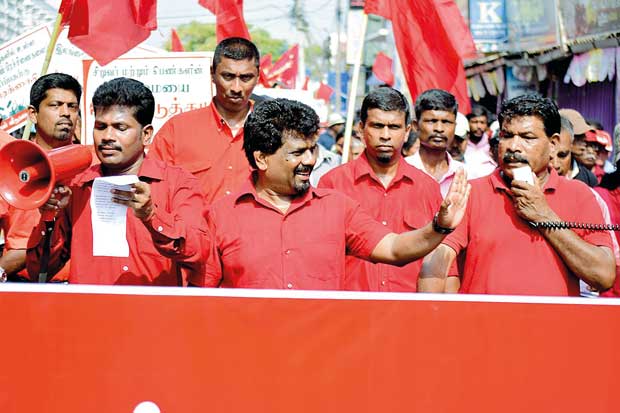The New Left: A new hope?
 People are aware of the enormous and exorbitant expense in terms of human lives and resources that revolutions necessitate
People are aware of the enormous and exorbitant expense in terms of human lives and resources that revolutions necessitate
The truth is that the New Left, be it the JVP or the Frontline Socialists, is the only proper movement in this country which defends the public sphere against the private
2017-11-24
 Not too long ago before the American election unfolded and upset what was predicted to be a Hillary Clinton victory, I posted the following comment: “Clinton is a domestic
Not too long ago before the American election unfolded and upset what was predicted to be a Hillary Clinton victory, I posted the following comment: “Clinton is a domestic  dove and foreign policy dove. Trump a domestic hawk and foreign policy dove.” This was a simplification on my part, but one that was based on the belief we held as sacrosanct at the time that Donald Trump would deliver on his promises and take the United States away from the interventionist streak it had been cursed with since the George W. Bush regime. Things don’t always transpire as we expect them to and now you have Donald Trump, who promised to keep America from foreign misadventures the same way Charles Lindberg had during the Second World War, reneging on those promises.
dove and foreign policy dove. Trump a domestic hawk and foreign policy dove.” This was a simplification on my part, but one that was based on the belief we held as sacrosanct at the time that Donald Trump would deliver on his promises and take the United States away from the interventionist streak it had been cursed with since the George W. Bush regime. Things don’t always transpire as we expect them to and now you have Donald Trump, who promised to keep America from foreign misadventures the same way Charles Lindberg had during the Second World War, reneging on those promises. The New Left had done what the Old Left had not; take its fringe movement beyond the upper classes
The comment gleaned two fundamentally opposite responses. One was from an American, an unabashed supporter of Clinton, i.e. a liberal: “You are making a mistake. Foreign policy is almost always tied to domestic policy goals.” The other was from a Sri Lankan with leftist inclinations: “Hillary Clinton is part of the neo-liberal right-wing.” The former tried to equate the two sectors I had differentiated; the latter did pretty much the same thing by contending that Clinton’s foreign policy objectives were based on neo-conservative, neo-liberal domestic and economic policy objectives. It was all a matter of perspective, put simply, and now I realise how erroneous it was of me to make such a simplistic distinction with respect to a political movement involving an entire country.
Month of revolution
It’s roughly the same story with our Left movement. There is rhetoric and there is perspective. Being the month of revolution I suppose the leftists will have their say in the matter of “out-lefting” their ideological opponents within and outside their movements. Being the month of Lenin and Marx and Trotsky the new and the old left will probably get together by their denunciations of the capitalist order. And being the month of their own stalled project the New Left in particular will be commemorating their dead, those  who were murdered for their political affiliations. (They were, as Malinda Seneviratne put it, killed for the sin of being born during the wrong decade, the wrong convictions.)
who were murdered for their political affiliations. (They were, as Malinda Seneviratne put it, killed for the sin of being born during the wrong decade, the wrong convictions.)
They weren’t the only ones who suffered though. They also made the people suffer. That is why perspectives matter. This was evident in the 1971 insurrection, when the likes of Colvin R. De Silva and N. M. Perera referred to them as fascists. But the New Leftists were never fascistic. They were only desperate. Consequently, they made the people desperate, somewhat overzealously. The idealism of Old Left rhetoric disappeared with those who were made to disappear. The second insurrection, bloodier and more enduring (for all the wrong reasons), was born out of this shattered idealism. From that shattered idealism evolved a new idealism, a new hope. For the first time in our left movement’s history, the youth, the educated and the unemployed, got involved. The New Left had done what the Old Left had not; take its fringe movement beyond the upper classes.
 who were murdered for their political affiliations. (They were, as Malinda Seneviratne put it, killed for the sin of being born during the wrong decade, the wrong convictions.)
who were murdered for their political affiliations. (They were, as Malinda Seneviratne put it, killed for the sin of being born during the wrong decade, the wrong convictions.) They weren’t the only ones who suffered though. They also made the people suffer. That is why perspectives matter. This was evident in the 1971 insurrection, when the likes of Colvin R. De Silva and N. M. Perera referred to them as fascists. But the New Leftists were never fascistic. They were only desperate. Consequently, they made the people desperate, somewhat overzealously. The idealism of Old Left rhetoric disappeared with those who were made to disappear. The second insurrection, bloodier and more enduring (for all the wrong reasons), was born out of this shattered idealism. From that shattered idealism evolved a new idealism, a new hope. For the first time in our left movement’s history, the youth, the educated and the unemployed, got involved. The New Left had done what the Old Left had not; take its fringe movement beyond the upper classes.
Substituting action for rhetoric
The JVP and its affiliated offshoots including the Deshapremi Janatha Viyaparaya substituted action for rhetoric in the bloodiest, most violent way possible. They were merely stoking the fires that the State, then headed by the UNP, was about to unleash on the country. They were the provocateurs, not that this absolves the State by any stretch of the imagination. Those who joined them were not just hard done by, they were also disgusted by what they felt was a lack of understanding and sympathy by a largely conservative society. There’s a saying that everyone is a socialist at 20, which was pretty much true of the eighties here. I’ve heard stories of teenagers who ran away from home, because of personal tussles with their parents and relatives, and joined the JVP. They were there for a reason. They were sick, tired, and wanted something, anything, that could let those elders know that they cared. They did this by resorting to the gun.
It is true that youthful idealism is at the heart of any revolution, and in the case of the JVP and the DJV that idealism was a response to the contortion of political realities in the South by various State actors, including the president and the military. Nanda Malini in her song “Rana Derane” implores a soldier to not shoot a member of his own class for the sake of vested class interests elsewhere. That was how determined and resolved the insurrectionists were. The result, in fact the only result, of all this was the creation of a powerful ideological apparatus in our institutions; our Universities, our Trade Unions, but not our political periphery where compromise was and is the name of the game and once political membership was guaranteed even the purest of pure revolutionists would turn away from their ideological convictions. No, our New Left was largely self-financed, rooted in youthful idealism, provocative, and opposed to what 1956 bred; a bifurcation of our public sphere between the few who had power and the many who had no power.
It is true that youthful idealism is at the heart of any revolution, and in the case of the JVP and the DJV that idealism was a response to the contortion of political realities in the South by various State actors, including the president and the military. Nanda Malini in her song “Rana Derane” implores a soldier to not shoot a member of his own class for the sake of vested class interests elsewhere. That was how determined and resolved the insurrectionists were. The result, in fact the only result, of all this was the creation of a powerful ideological apparatus in our institutions; our Universities, our Trade Unions, but not our political periphery where compromise was and is the name of the game and once political membership was guaranteed even the purest of pure revolutionists would turn away from their ideological convictions. No, our New Left was largely self-financed, rooted in youthful idealism, provocative, and opposed to what 1956 bred; a bifurcation of our public sphere between the few who had power and the many who had no power.
Rift
The bifurcation of our intelligentsia into swabasha and non-swabasha has been debated by two schools of thought. One of them contends that 1956 represented the dislodgment of the elite (Kumari Jayawardena); the other contends that it represented the substitution of a more insidious form of class discrepancies for the discrepancies that had existed until then (Regi Siriwardena). What this leaves out is a third possible theory, which I subscribe to: that 1956 represented a bifurcation into the swabasha multitude and non-swabasha elite that appropriated privileges so much for the latter that a rift developed within the former between those who wanted to maintain their identity and those who wished to join the elite. The proponents of the federalist-devolutionist discourse, who joined the NGO intelligentsia despite their rural backgrounds, belong to this specific social subset.
The idealism of Old Left rhetoric disappeared with those who were made to disappear
The truth is that this Left movement was spent long, long ago. The truth is that the New Left had to be the ideological shapers of that movement. The truth is that not even a bheeshanaya could dislodge the peripheries of power that developed within our Universities. As long as the State remained apathetic, as long as the Old Left was seen to be flirting with the status quo, those peripheries would stay in place. The rift between the Communists and Stalinists on the one hand and the Trotskyites on the other was largely an ideological one borne out of personal convictions. The rift between the Old and the New was more than just ideological; it was a statement for those who wished to do away with the establishment and against that aforementioned social subset that sided with it. The split in the latter, between the JVP and the Peratugami Samajawadi Pakshaya, was not unlike the ideological splits in the former during the forties and the fifties, with the caveat that it has not been enough yet to erode the dominance of the JVP.
I hate taking sides in any revolution, but I am aware of the enormous and exorbitant expense, in terms of human lives and resources, that such revolutions necessitate. When the Cuban revolution played out and was later intensified by the threat of outside invasion (courtesy of the US), you couldn’t have sided with José Miró Cardona, who became Prime Minister under Castro and later left, ostensibly disgusted with the new administration’s descent to an authoritarian state, to become his fiercest ideological opponent. When the Russian Revolution played out you couldn’t have sided with the Mensheviks and the reformists. When the French Revolution played out you couldn’t have sided with the middle class bourgeoisie. You had to be the revolutionist or join those who wanted the revolutionists out. Moderates and intermediaries were not popular on either side. Human lives are lost, damage is inflicted on property, but these are prerequisites to any secular revolution and upheaval. It was no different in Sri Lanka.
The truth is that the New Left, be it the JVP or the Frontline Socialists, is the only proper movement in this country which defends the public sphere against the private. The tussle over the SAITM issue, the spate of strikes in the Electricity Board and the railway sector, indicate quite clearly that they remain as potent as ever, even if those who lead these strikes and protest movements are different to and more committed than the individuals who lead their parties. Let’s not forget, after all, that last year’s private bus strike was carried out independently, without the express approval of the president of the Private Bus Owners’ Association. Let’s not forget that in pretty much every movement of this kind a rift exists between the leadership that flirts with the status quo and the membership that survives and thrives on and flourishes through (youthful) idealism.
We ought to be thankful, I should think. Particularly in a context where 37 years of globalisation and neo-liberalism in Sri Lanka has led us, not up the garden path, but down the rocky slope. The private sphere pretty much determines the public, an issue I wish to tackle in a later column. For now, however, let us reflect on this month of revolution, on the men and women who laid their lives, and the idealisms that bred and nurtured them.
